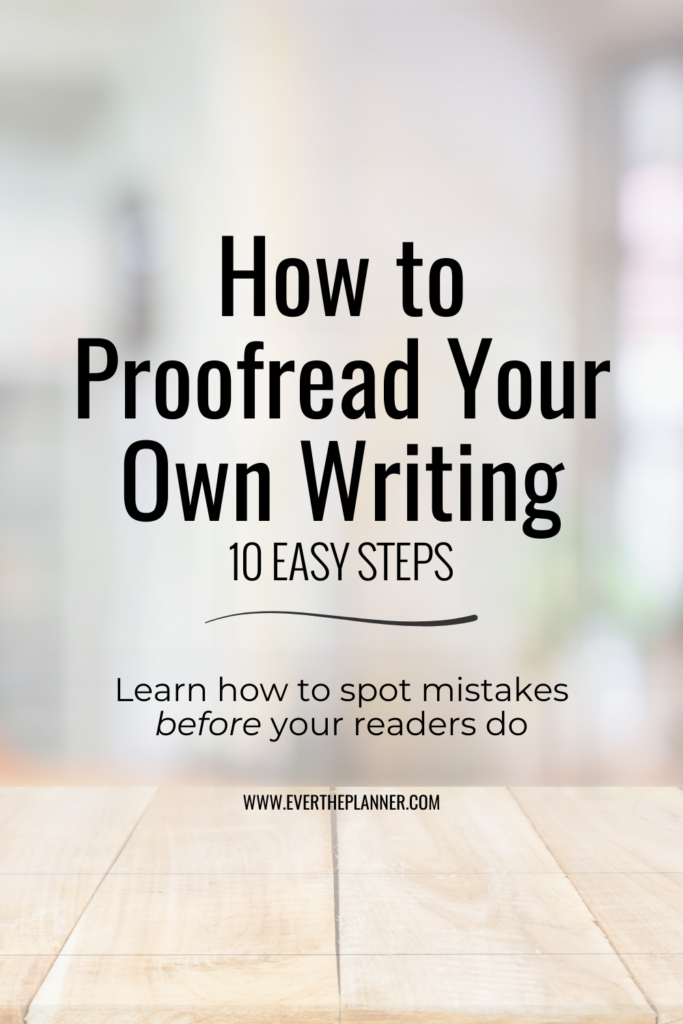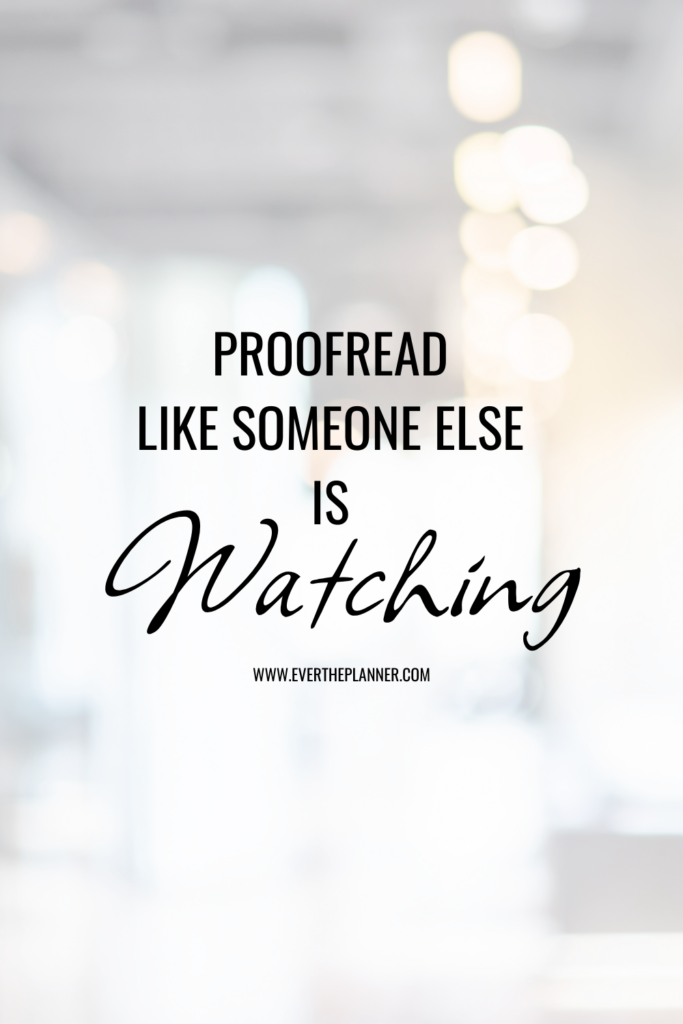How to Proofread Your Own Writing: 10 Easy Steps for Beginners

Still finding mistakes after you hit publish? You’re not the only one. If you’ve ever re-read something you wrote and spotted a sneaky typo after it went live… yeah, that stings. Catching your own errors is harder than it looks—but once you learn how to proofread your own writing, it gets a whole lot easier.
This guide walks you through a 10-step proofreading process that’s simple, fast, and actually works—even if you don’t consider yourself a “grammar person.” No fancy hacks. No technical jargon. Just real steps you can use right away, whether you’re reviewing a blog post, an email, or a client project.
Let’s make your writing look just as polished as the work behind it.
🔍 TL;DR: What You’ll Learn
- Why spotting your own mistakes is so tricky (you’re not broken, it’s science)
- 10 beginner-friendly proofreading steps that actually help
- Quick tips to catch more errors before you hit publish
Before we jump into the steps, let’s get on the same page about what proofreading really is—and how it’s different from editing.
What is Proofreading?
Proofreading is your last line of defense before you hit publish.
It’s the final step where you read through your writing to catch the small stuff—typos, grammar slips, awkward wording, or a word that just… vanished. Think of it as a quick polish to help your content look and sound its best.
And no, it’s not the same thing as editing.
Editing is for the big-picture changes—rewriting messy sections, fixing confusing ideas, or rearranging things so they flow better.
Proofreading comes after all that.
It’s where you zoom in and double-check the details that are easy to miss.
Even experienced writers make mistakes—it’s totally normal. But the difference is, they take the time to proofread. And when you do, your content instantly feels more professional, more trustworthy, and way more reader-friendly.
Why It’s Hard to Proofread Your Own Writing—and Why It Matters
When you’ve spent a lot of time writing, it’s easy to miss small mistakes. Your brain knows what you meant to say, so it automatically fills in missing words or skips over tiny errors without you even noticing.
That’s why learning how to proofread your own writing is such an important skill. It helps you slow down, see your work with fresh eyes, and catch the little things before anyone else does.
It’s not just about fixing typos, either.
Clean, polished writing builds trust. Even a single slip-up can make your writing feel less trustworthy—even if the content is solid. (It’s not fair, but it happens.) That’s why so many proofreading tips for beginners focus on slowing down and taking your time—because your readers will notice.
Proofreading also saves you from bigger headaches later. Taking a few extra minutes now can mean fewer corrections after your work is out in the world. It’s one of the best ways to proofread your work and protect your credibility long-term.
10 Beginner-Friendly Steps to Proofread Your Own Writing
Proofreading your own writing doesn’t have to feel overwhelming.
With the right approach, you can catch more mistakes, feel more confident, and polish your work without overthinking it. You don’t need to be an expert—these steps to proofread a document are designed to keep things simple and effective, especially if you’re new to it.

Step 1: Step Away Before You Proofread
After you finish writing, take a short break — even 10 to 20 minutes helps. When you come back with fresh eyes, it’s much easier to catch mistakes in your writing that your brain glossed over before.
Step 2: Focus on One Thing at a Time
Trying to fix everything in one pass can feel chaotic. Instead, check for one type of error at a time — like spelling first, then punctuation, then grammar. It’s one of the best ways to self-edit your writing without missing the little things.
Step 3: Read It Out Loud
Reading your work out loud forces you to slow down. You’ll hear awkward wording, repeated words, and skipped phrases that are easy to miss when reading silently.
Step 4: Change How It Looks
Trick your brain into paying closer attention. Print your work out, or switch up the font style and size on your screen. A small change in format can help you see your writing differently—and catch more errors.
Step 5: Use Editing Tools (But Don’t Rely on Them)
Tools like Grammarly and spellcheck can help—but they won’t catch everything. Use them as a first filter, then follow up with your own human judgment. You’re smarter than the algorithm.
Step 6: Check Your Punctuation
Punctuation is easy to overlook, but it can totally change meaning. Give extra attention to commas, periods, apostrophes, and quotation marks. This is a big part of how to proofread your own writing with care.
Step 7: Double-Check Names and Details
Proper names, places, and titles are easy to get wrong—and hard to catch later. Always slow down and verify them, especially in professional or client-facing work.
Step 8: Know Your Common Mistakes
Everyone has writing quirks. Maybe you mix up “your” and “you’re” or skip little words like “a” and “the.” Keep a running list of your usual errors and scan for them every time you proofread. This is how you build your own system for how to self-edit your writing more effectively.
Step 9: Read Backwards, Sentence by Sentence
Reading your document backward (from the last sentence to the first) keeps your brain from skimming. It helps you focus on sentence structure instead of the story, which makes catching mistakes much easier.
Step 10: Do a Final, Slow Read
Now that you’ve gone through all the steps, read your piece slowly from start to finish. This last pass is for flow, tone, and final polish—the part that makes your writing feel clear, intentional, and ready to publish.
Quick Proofreading Tips for Beginners
Proofreading is a skill you build with time, but a few smart habits can help you improve faster.
These quick tips are perfect for beginners learning how to catch mistakes in writing and build a smoother proofreading process.
📌 Tip 1: Create a distraction-free zone
Proofreading requires focus. Turn off notifications, close extra tabs, and find a quiet spot so your brain can zero in on the details.
📌 Tip 2: Use a proofreading-specific checklist
Make a list of things you tend to overlook—like double spaces, extra punctuation, or homophone mix-ups—and run through it every time you proofread. (Bonus: reuse it across all your writing.)
📌 Tip 3: Proofread in short bursts
If you’re working on a long piece, break up your proofreading into sections. Shorter sessions help you stay sharp and avoid zoning out.
📌 Tip 4: Read it in a different format
Preview your writing in the format your readers will see—like a mobile screen, PDF, or website draft. This context shift can help you catch layout issues or awkward phrasing you’d miss in a doc.
📌 Tip 5: Keep a “watch list” of personal slip-ups
Start a running list of your most common mistakes—whether it’s using passive voice or forgetting end punctuation in captions. Over time, this becomes your own custom guide for how to self-edit your writing.

Last, But Not Least:
Need to be extra sure? Professional eyes can help. When it’s a high-stakes project or something public-facing, having someone else review your work is often the best way to proofread your work thoroughly.
If you’d like a second set of eyes, I offer professional proofreading services tailored for bloggers. I’ll help you catch the little things, improve flow and clarity, and make sure your words shine—so you can hit publish with confidence. Learn more here.
Final Thoughts: You Can Learn How to Proofread Your Own Writing
Proofreading your own writing isn’t always easy—but it’s a skill you can absolutely get better at.
With practice and a simple process (like the 10 steps you’ve learned today), it becomes easier to catch mistakes in your writing and feel more confident in your final draft.
And here’s something worth repeating: it’s completely normal to miss things. Even experienced writers overlook typos—that’s why second sets of eyes exist.
So be patient with yourself. Slow down. Keep showing up.
Every time you proofread with care, you’re building habits that will make all your future writing stronger and more professional.
You’ve already done the hardest part: showing up to improve. Keep going—your writing will thank you for it.





Be the first to comment